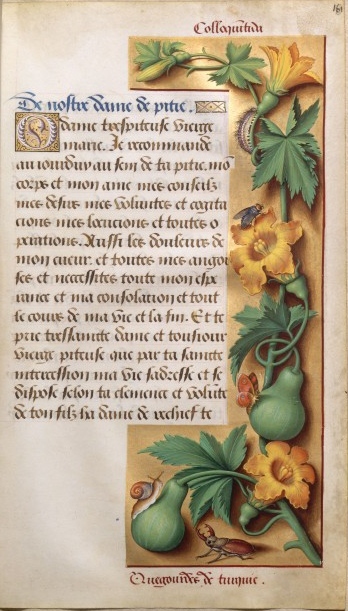The pumpkins, squashes, and gourds of Cucurbita were among the earliest crops domesticated. Evidence for C. pepo cultivation comes from about 10,000–9000 BP (Mesoamerica), followed by C. argyrosperma (Mexico – 7000 BP), C. moschata (southern Mexico – 7000 BP), C. ficifolia (Peru – 5000 BP) and C. maxima (Peru – 4000 BP). Many of the species were first domesticated for their edible seeds and were gradually changed into thick-fleshed containers through artificial selection. The squashes and gourds were important components of the diets of the Aztecs, Incas and Mayas and the Amerindians carried them throughout North America.
The New World Cucurbita pepo and C. maxima were introduced to Europe at the beginning of the 16th century, while C. moschata arrived a few decades later, perhaps due to its more restricted distribution in Mesoamerica. The cucurbits entry into Europe was well documented in multiple works of art. Two illustrations of C. pepo appear in De Historia Stirpium of Leonhart Fuchs (1542). The first representation of a cucurbit in Europe is a painting of C. pepo subsp. texana found in the prayer book Horae ad usum Romanum, dites Grandes Heures painted for the Queen of France Anne de Bretagne, by Jean Bourdichon between 1503 and 1508.The festoons painted on the ceiling of the Villa Farnesna between 1515 and 1518 in the Loggia of Cupid and Psyche also contain multiple examples of Cucurbita maxima and C. pepo. In addition, representations of New World cucurbits can be found in the portrait heads of fruit, vegetables, and flowers made up by Giuseppe Archimboldo in the mid-1500s and the 1580 paintings of the Fruit Seller by Vincenzo Campi.
How seeds of cucurbits got into France before 1503 to be depicted in the Queen’s prayer book is a bit of a puzzle. Paris et al. (2006 – pg. 46) suggests that “the harbours of Brittany (Bretagne) and Normandy had close historical and commercial ties with Great Britain, and British and French sailors reached the Americas by 1503.” Cucurbits were being grown by the Amerindians on the east coast of North America during that period. “Moreover, the Bretons and Normans actively traded with the Spanish and Portuguese. Europeans, including Amerigo Vespucci, entered the Gulf of Mexico as early as 1498, offering possible opportunities for encountering and collecting Cucurbita pepo. Goods brought by officially sponsored Spanish and Portuguese ships returning from the Americas were of immediate interest to European royalty and to the papacy.”
Soon after the cucurbits arrived in Spain, they were being widely grown in gardens across Europe, but most Europeans were slow to actually eat them. In France, they were used mainly as animal fodder, and in Italy cucurbits were “thought of contemptuously as food for the poor” (Paster, 2018). Iberian Jews were among the first to embrace pumpkin as a food source, and when they fled Spain during the Inquisition, they took them along to nearby Italy. Ravioli filled with pumpkin was originally a Sephardic creation, along with pumpkin puree, pumpkin flan, and pumpkin fritters, a Hanukkah delicacy.
Pumpkin was introduced to China’s southeastern coastal areas and southwestern frontiers in the early sixteenth century like maize, and rapidly spread across the country serving as both a vegetable and staple. The earliest records of pumpkin in Gazetteers appear in Fujian in 1538, Guangdong in 1545, and Zhejiang in 1551. By the end of the 15th century, it had spread to most provinces of China and was nationwide in the mid-1600s.
There are few records of cucurbit dispersal to Africa, India, and Indonesia, but presumably, they were also moved there by Portuguese merchants in the early 16th century, like maize and chili peppers. In fact, many of the early introductions of cucurbits to Europe may have come from plantings established in southern Asia. The cucurbits were so widely distributed across the Old World by the 1800s that many European botanists assumed they had an Old World origin.
Illustration: The Grandes Heures of Anne of Brittany: Cucurbita pepo subsp. texana, f. 161 File:Bnf Anne f161.jpg – Wikimedia Commons
Bibliography:
Hancock, J. F. (2022) World agriculture before and after 1492: The legacy of the Columbian Exchange. Springer.
Janick, J. (2013) Development of new world crops by indigenous Americans. HortScience 48 (4): 406-412.
Janick, J. (2020) Iconography of domesticated sunflower. Notulae Botanicae Horti Agrobotanici Cluj-Napoca 48(3):1116-1129.
Merrick, L.C. (1995) Squashes, pumpkins and gourds. In: Smart, J. and Simmonds, N. Evolution of Crop plants. Second Edition. Longman Scientific and Technical, Essex, UK. P 97-105.
Paris, H.F. (1989) Historical records, origins and development of edible cultivar groups of Cucurbita pepo (Cucurbitaceae). Economic Botany 43:423-443.
Paris, H.S., Daunay, M-C, Pitrat, M. and Janick, J. (2006) First Known Image of Cucurbita in Europe, 1503–1508. Annals of Botany 98: 41-47.
Sauer, J. D. (1993). Historical geography of crop plants: a select roster. CRC press
Whitaker, T.W. (1947) American origin of the cultivated cucurbits. I. Evidence from the herbals. II. Survey of old and recent botanical evidence. Annals of the Missouri Botanical Garden 34: 101-111.
Xinsheng, L. and Siming, W. (2017) The introduction and spread of pumpkin in China. Chinese Annals of History of Science and Technology 1:94–112
